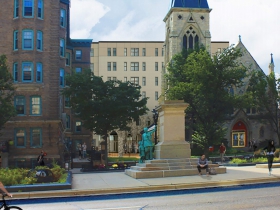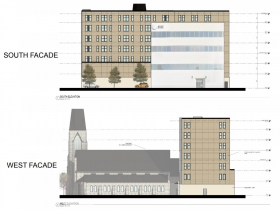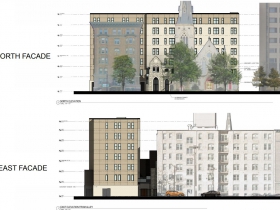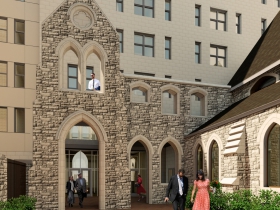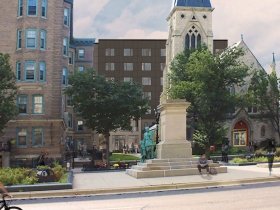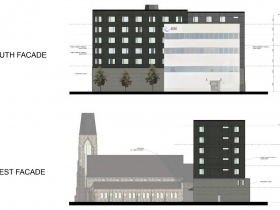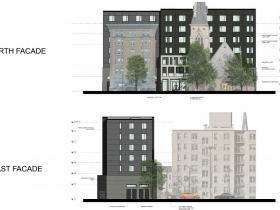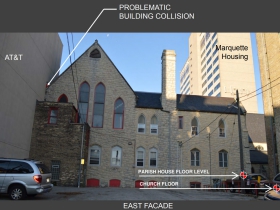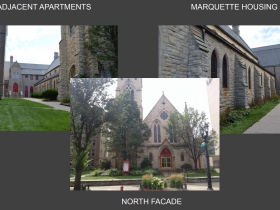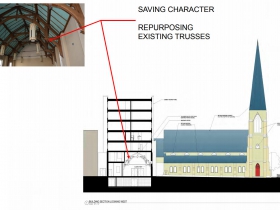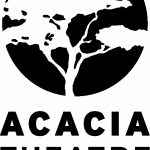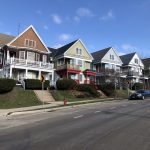St. James Project Stuck in Committee
Developer would redevelop church, but can't get past Historic Preservation Commission.
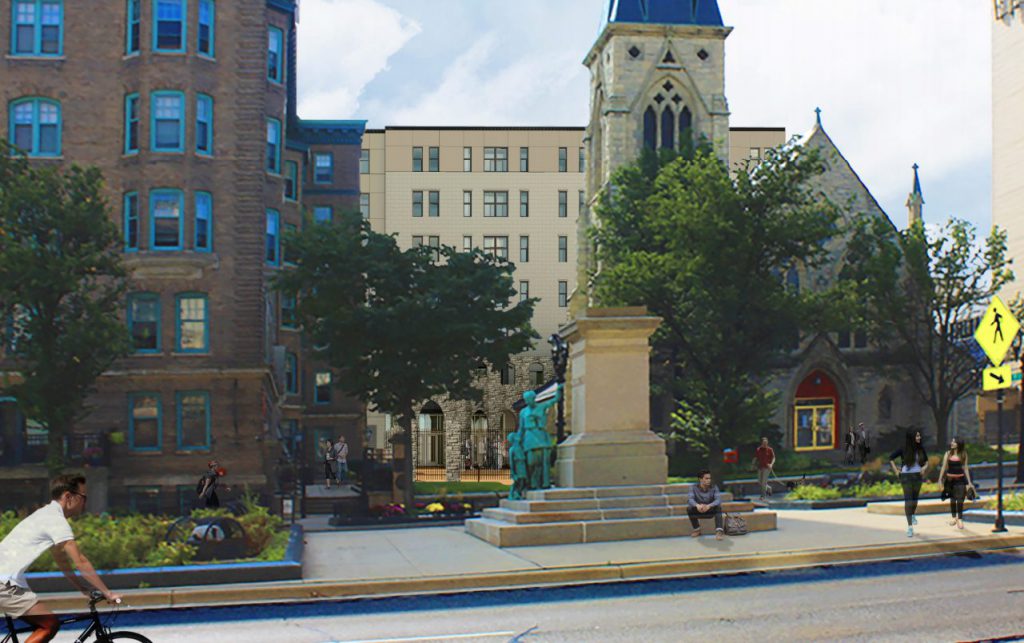
Updated rendering of St. James Episcopal Church Redevelopment. Rendering by Engberg Anderson Architects.
Though the plans have been updated, the proposal by developer Joshua Jeffers to redevelop the former St. James Episcopal Church at 833 W. Wisconsin Ave. into an apartment building and event venue is still being held by the Historic Preservation Commission.
The commission hasn’t rejected the project; it’s just failed to take definitive action. In December the commission members held the proposal, awaiting more information on it. Thursday afternoon, with only four of five members present, they deadlocked on the proposal after taking a vote and ultimately held the matter.
The matter is scheduled to be revisited again at the commission’s next meeting on March 5th.
J. Jeffers & Co. intends to redevelop the historic church, which dates back to 1867, into an event venue in a partnership with Hidden Kitchen MKE. To achieve that, Jeffers would demolish the parish house addition added in 1899 and construct a seven-story building that includes an additional event venue and support functions on the lower floors, with apartments on the upper floors. Design work on the project is being led by Engberg Anderson Architects.
Commission chair Robert Bauman, who represents the area on the Common Council, told his fellow commissioners that the merits of the two-step project should be debated separately. First, Jeffers must secure an application to demolish the parish house. Second, Jeffers must secure a certificate of appropriateness for the design of the new building he wishes to erect.
Bauman’s splitting of the two decisions didn’t seem to simplify anyone’s decision, but it did shorten the debate. The merits of the revised design (shown below), which has been updated to include preserving much of the facade of the parish house, were never discussed.
The historic preservation staff, after examining the proposal in depth, told the commission they are neutral on the application.
If the commission ultimately rejects either the demolition certificate or the design, Jeffers will have the right to appeal to the Common Council. When the project goes before the council’s Zoning, Neighborhoods & Development Committee, Jeffers will find a committee that can hear economic arguments and will likely be more sympathetic to his proposal.
The project has the support of at least one former member of the church, Lucy Cooper, and likely many others. She told the commission “the people of St. James, the ones I’m still in contact with, are very much in favor of this proposal.” Cooper noted that the church exhausted their options over a period of three years in terms of finding another church to take over or share the city’s oldest stone-built church.
John Hennessy, who owns the adjacent St. James Apartments, supports the project. He told the commission that demolishing the rear parish house would support maintaining the character of historic W. Wisconsin Ave. The city has invested in the upkeep of the area in recent years, including the recent re-installation of the statue of George Washington in the street’s median.
While the commission faces a difficult decision, the project isn’t any less challenging for Jeffers. He previously told the commission “for us to convert the 1899 addition into something that is both historically accurate and built to modern code compliance, it would be enormously costly… This building has more asbestos in it proportionally than any other building I’ve seen.”
“It became evident why this property has been for sale for many years, it’s just too darn costly to turn it into anything else,” said Jeffers. Those thoughts were echoed by Engberg Anderson partner Mark Ernst, who said his firm has studied reusing the building in four or five different plans. “When Josh called I said ‘we have plans!’”
Bauman and commissioner Ann Pieper Eisenbrown ultimately voted for rejecting the demolition request. Pieper Eisenbrown said that since the commission couldn’t consider economic arguments the project didn’t satisfy the ordinance’s requirements for demolition.
Jarosz and Marion Clendenen-Acosta voted against the motion to deny, supporting Jeffers’ proposal. Jarosz said “I’ve looked for so many years now at the collection of unused churches we have in our city that are falling apart.” Clendenen-Acosta, an architect with Kahler Slater, said she had to consider other factors.
Commission member Patti Keating Kahn was absent from the hearing.
For more information on the proposal and historic church, see my column from November 2017 examining the proposal.
Updated Plans
Original Plans
If you think stories like this are important, become a member of Urban Milwaukee and help support real independent journalism. Plus you get some cool added benefits, all detailed here.
Political Contributions Tracker
Displaying political contributions between people mentioned in this story. Learn more.
- October 13, 2019 - Robert Bauman received $100 from Patti Keating Kahn
- March 23, 2017 - Robert Bauman received $50 from Ann Pieper Eisenbrown
- March 23, 2017 - Robert Bauman received $250 from Patti Keating Kahn
- May 10, 2016 - Robert Bauman received $250 from Patti Keating Kahn
- February 13, 2016 - Robert Bauman received $100 from Joshua Jeffers
- September 4, 2014 - Robert Bauman received $50 from Ann Pieper Eisenbrown
Eyes on Milwaukee
-
Church, Cupid Partner On Affordable Housing
 Dec 4th, 2023 by Jeramey Jannene
Dec 4th, 2023 by Jeramey Jannene
-
Downtown Building Sells For Nearly Twice Its Assessed Value
 Nov 12th, 2023 by Jeramey Jannene
Nov 12th, 2023 by Jeramey Jannene
-
Immigration Office Moving To 310W Building
 Oct 25th, 2023 by Jeramey Jannene
Oct 25th, 2023 by Jeramey Jannene


